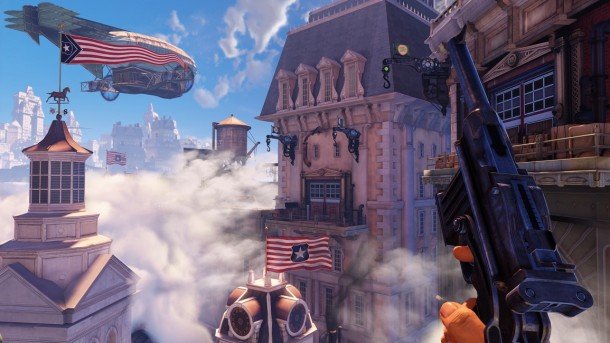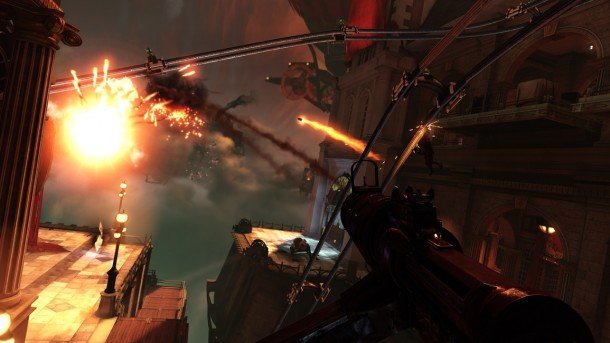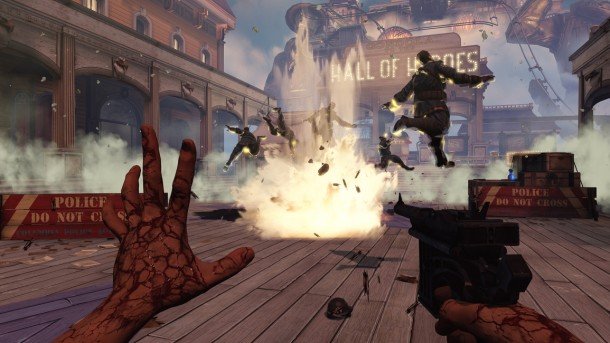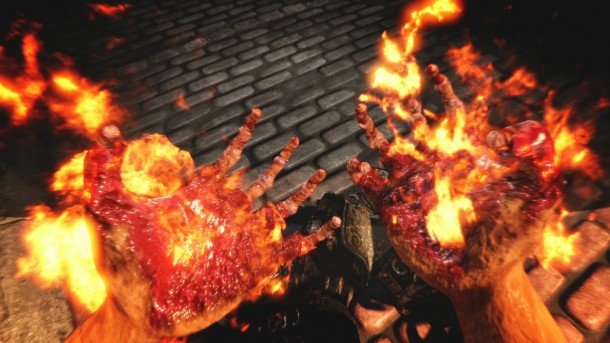BioShock Infinite: first impressions from our massive hands-on (spoiler free)

I've just played the first five hours of BioShock Infinite, and I've come away with the same dazed feeling I got after I first played Half-Life 2. It's a sensory overload: a relentless series of staggering sights, astonishing events, and more story and detail and mysteries than I could possibly absorb.
I'm not quite sure what I was expecting, but not this.
I'll be writing up my full impressions, and my interview with creative director Ken Levine, for the next issue of PC Gamer UK. Evan's also been playing it, and will bring you a longer and slightly more spoilery exploration of the things he liked most about the demo later today. For now, let me give you an overview of the main stuff I wanted to know before I played.

What do you actually do?
It's very, very story driven. Remember washing up at a lighthouse and discovering Rapture for yourself in BioShock 1? BioShock Infinite's equivalent of that lasts an hour. When the fighting finally does break out, it's frantic and chaotic and recognisably BioShock. But then you're straight back to being led through extraordinary new places by the story. There's time to explore, and masses to see, but it never settled into a formula in the time I played: you're always being put in completely new situations.

Does it feel like a BioShock game?
At first, yes: you're quietly exploring a strange new place and finding clues to the story of what happened here in evidence scattered around, from graffitti to audio diaries. But then you find people. Not enemies, just people. At some point you start to encounter more hostiles, but it never switches entirely to you vs the world: each new area of the floating city starts out with civilians neutral to you.
Keep up to date with the most important stories and the best deals, as picked by the PC Gamer team.
When you find the girl you're here for, Elizabeth, she changes the mood even further from BioShock's. She's with you at all times, as far as I played, and she's both talkative and central to the plot.

What's the combat like?
Very much like BioShock: gun in one hand, spell in the other. The big difference is the spaces you do it in: fighting in a city of floating buildings means a lot of big, open areas with rooftops, balconies and drifting blimps at different heights. Sky rails snake through these spaces, twisting like rollercoaster tracks, and you can leap on and off these any time: they're magnetised, so your skyhook thingy can pull you up to them from quite far away. Racing around these, launching yourself off to new vantage points or directly onto enemies, gives combat a much more acrobatic and fast-changing feel.
The spells - Vigors - are very much like BioShock 2's: turn people to your side, set them on fire, fling them into the air, cover them in crows (previously bees). They're all good. The guns are less exciting: marginally more satisfying than BioShock's, but still not particularly fun to use by themselves.

What's the best thing about it?
Definitely the place. A city floating in the clouds is a cool thing, and we already knew that, but I wasn't at all prepared for how striking and fresh each new bit of it would be. Temples awash with holy water, gold light and gospel music. City streets fogged with cloud, kids playing and townsfolk chatting, all just silhouettes in the water vapour. Dark mansions, banquet halls of rotting food, crows pecking at everything.
All of it's packed with clues and traces of the story, and the story is bizarre, complicated and fascinating. Can't wait to explore more of it.
It's out March 26th. My full preview will be in our issue out in the UK on January 17th.


